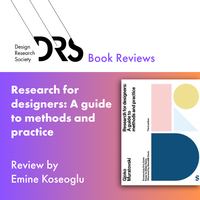
Book Details
Research for Designers: A Guide to Methods and Practice
Gjoko Muratovski
SAGE Publications, 2024
368 pp.
ISBN: 978-1-5296-6998-5
Research for design and/or research of design?
Today in design practice and education, research is central rather than a fringe affair—it is a critical part of the way we think through, develop, and test design work. Gjoko Muratovski’s Research for Designers: A Guide to Methods and Practice has now emerged as a much-needed landmark piece, and it addresses a recurring gap in the field of how to engage with research not as an academic add-on but as a fundamental part of the design process: ‘But above all, learning how to do research is a lifelong skill that helps people advance their critical thinking abilities. Also, research is a major component in many university-based design programmes and large organizations’ (p.3).
What makes this book so engaging is the clear statement of intent. It aims to demystify research for designers without oversimplifying it:
‘If you are a beginning researcher, this book will provide you with information on how to embark on a research path, how to develop research questions, how to select appropriate research methods, how to communicate your research to the relevant stakeholders, and how to convert your research into a professional design brief that will lead to an effective design solution. If you are a seasoned researcher, professional designer, or a senior academic, this book can also provide you with a set of practical applications and insights that can help you advance your work further’ (p.3).
Thus, from early stages such as formulating a research question and conducting literature reviews, to the more technical phases of data gathering and analysis, Muratovski provides a linear yet flexible framework that resonates with the project-based rhythm of design work.
The book's greatest strength lies in its embedded call toward an interdisciplinary, multi-disciplinary, cross-disciplinary and trans-disciplinary research attitude. For readers accustomed to visual, intuitive, and iterative ways of working, the fusion of the diverse disciplinary approaches enables a more critical, situated, and inclusive perspective toward design:
‘Academic design research often differs markedly from research that is commonly found in design practice – even though this should not be the case. Unlike practice-based research, which is often self-reflective in nature and is aimed at improving the practice of the individual or the team, academic design research aims to advance, change, or challenge the normative body of the design field and to gather a deeper understanding of the field itself’ (p.3).
Another valuable element is the inclusion of practitioner voices. Muratovski interviews professional designers, and their experience provides grounded insight into the actual operation of research in practice and research-driven design processes. These texts of dialogue between the author and the interviewee do not just illustrate; they anchor the book’s arguments in practice.
Moreover, turning to the research titles, the reader can engage with a broader spectrum of research attitudes adaptable to design, ranging from quantitative methods to ethnographic research:
‘In fact, ethnography has become a very valuable research method for designers. By conducting ethnographic research, designers can now study various types of human behaviour, the cultural practices that occur in different societies and environments, and the objects that are integral to those practices’ (p.82).
Muratovski does not simply stop at outlining these approaches, rather, he takes it further by bridging methodological frames with practical strategies for effectively presenting research, aligning this closely with familiar phases of design practice.
Stylistically, the book maintains an approachable and instructive tone, making it ideal for both design students and educators. Each chapter is supported by visual aids, key takeaways, and digestible summaries and interviews that reinforce the book’s educational usability. In studio settings and graduate courses, features like these are not merely useful but they are essential for maintaining a structured workflow and fostering more refined discussions for specific design cases and experiments.
Arguably, Research for Designers succeeds in its main goal: it equips designers with conceptual tools and aligned methodological awareness to conduct research that is rigorous, relevant, and responsive to real-world complexities. While it does not claim to offer definitive solutions, it undoubtedly provides some solid paths for newcomers to confidently enter the world of design research.
In sum, Muratovski’s book is not only a pedagogical resource but also a conceptual challenge. It reminds us that good design is not just about form-making or innovation, but about inquiry, about framing the right problems before rushing into solutions. For anyone navigating the shifting terrains of design education, research practice, or studio pedagogy, this book serves as a strong and necessary guide remembering ‘that it is primarily meant for audiences who are new to research’ (p.2).
About the Reviewer
Dr. Emine Koseoglu is a professor of architecture at Fatih Sultan Mehmet Vakif University, Istanbul. She works at the intersection of architectural design, environmental psychology and urban morphology, mainly on spatial legibility, spatial perception, and levels of visual thinking in architecture combining analytical and artistic perspectives. She is currently pursuing conducting research projects and editorships in scientific journals in addition to renovating her office into a micro-loft while living in it.
